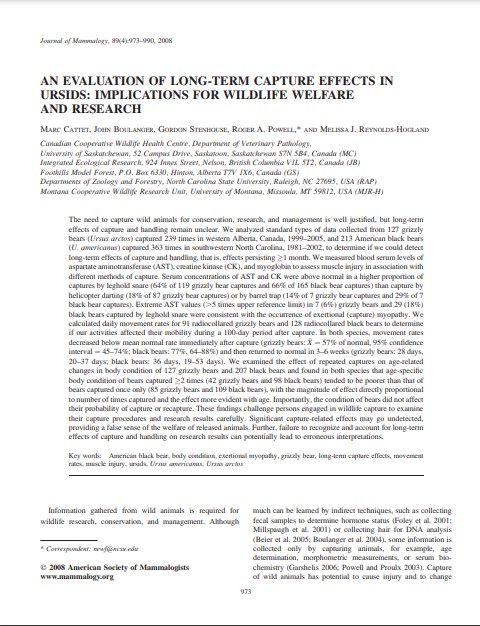An Evaluation of Long-term Capture Effects in Ursids: Implications for Wildlife Welfare and Research
Bosque Modelo:
Foothills
Temática:
Conservación
Tipo de documento:
Artículo científico
Resumen
The need to capture wild animals for conservation, research, and management is well justified, but long-term effects of capture and handling remain unclear. We analyzed standard types of data collected from 127 grizzly bears (Ursus arctos) captured 239 times in western Alberta, Canada, 1999–2005, and 213 American black bears (U. americanus) captured 363 times in southwestern North Carolina, 1981–2002, to determine if we could detect long-term effects of capture and handling, that is, effects persisting 1 month. We measured blood serum levels of aspartate aminotransferase (AST), creatine kinase (CK), and myoglobin to assess muscle injury in association with different methods of capture. Serum concentrations of AST and CK were above normal in a higher proportion of captures by leghold snare (64% of 119 grizzly bear captures and 66% of 165 black bear captures) than capture by helicopter darting (18% of 87 grizzly bear captures) or by barrel trap (14% of 7 grizzly bear captures and 29% of 7 black bear captures). Extreme AST values (.5 times upper reference limit) in 7 (6%) grizzly bears and 29 (18%) black bears captured by leghold snare were consistent with the occurrence of exertional (capture) myopathy. We calculated daily movement rates for 91 radiocollared grizzly bears and 128 radiocollared black bears to determine if our activities affected their mobility during a 100-day period after capture. In both species, movement rates decreased below mean normal rate immediately after capture (grizzly bears: X ¼ 57% of normal, 95% confidence interval ¼ 45–74%; black bears: 77%, 64–88%) and then returned to normal in 3–6 weeks (grizzly bears: 28 days, 20–37 days; black bears: 36 days, 19–53 days). We examined the effect of repeated captures on age-related changes in body condition of 127 grizzly bears and 207 black bears and found in both species that age-specific body condition of bears captured 2 times (42 grizzly bears and 98 black bears) tended to be poorer than that of bears captured once only (85 grizzly bears and 109 black bears), with the magnitude of effect directly proportional to number of times captured and the effect more evident with age. Importantly, the condition of bears did not affect their probability of capture or recapture. These findings challenge persons engaged in wildlife capture to examine their capture procedures and research results carefully. Significant capture-related effects may go undetected, providing a false sense of the welfare of released animals. Further, failure to recognize and account for long-term effects of capture and handling on research results can potentially lead to erroneous interpretations.
Información Bibliográfica
Autor:
Cattet, MRL, J Boulanger, G Stenhouse, RA Powell and MJ Reynolds-Hogland.
Revista:
Journal of Mammalogy
Año:
2008
N°:
4
País :
Canadá
Páginas:
973 - 990
Volumen:
89
Idioma:
Ingles
Palabras claves
American black bear, body condition, exertional myopathy, grizzly bear, long-term capture effects, movement rates, muscle injury, ursids, Ursus americanus, Ursus arctos





